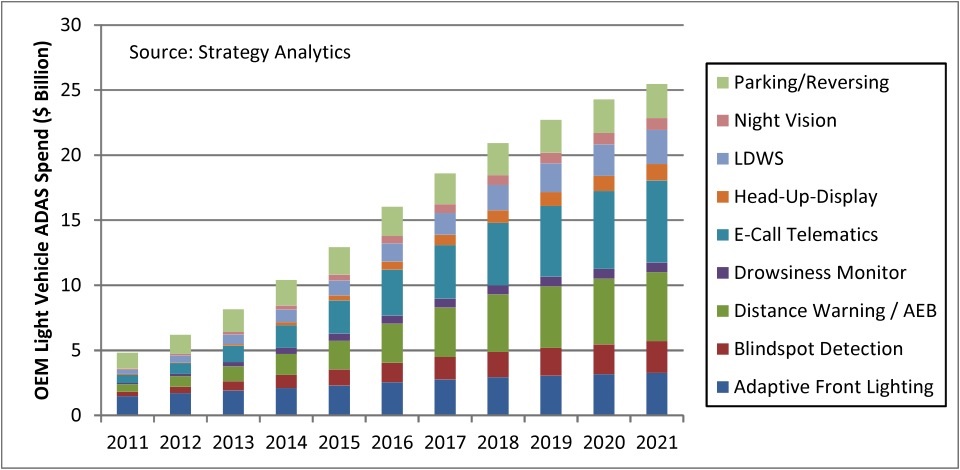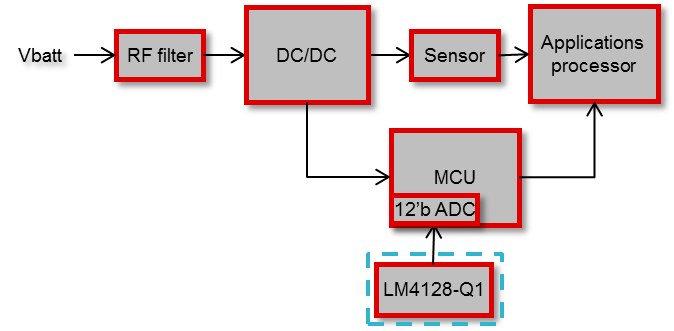SSZTBU5 december 2015 LM4041-N-Q1 , LM4050-N-Q1 , LM4128-Q1 , LM4132-Q1
Automotive rearview cameras have been on the market (and reducing backup accidents) since 2002. More recently, the National Highway Transportation Safety Administration (NHTSA) set a regulation for all cars sold in the U.S. to include rearview camera systems by 2018.
As a result, the market for advanced driver assistance systems (ADAS) has skyrocketed not only in the U.S., but also globally, and could reach an estimated $60.14 billion by 2020. and could reach an estimated $60.14 billion by 2020. Front-, rear- and surround-view camera systems are just a few examples of standard ADAS applications implemented in vehicles today. The deployment of various sensors such as RADAR, LIDAR and ultrasonic also plays a large role in parking assistance, lane-change proximity alert, and object detection from both near and far distances. Figure 1 shows the positive growth trajectory forecasted for multiple ADAS use cases over the next several years. More notably, applications such as E-call telematics and distance warning are expected to double in business by 2017.
 Figure 1 ADAS Market Growth According
to Strategy Analytics
Figure 1 ADAS Market Growth According
to Strategy AnalyticsOn the power-management side of these subsystems, you often need voltage references to monitor the voltage levels at various power stages. These devices are also widely used with data-processing devices such as microcontrollers (MCUs), ASICs, ADCs and sensors because the built-in reference may not be able to provide the accuracy needed to process the given data. TI’s shunt and series voltage references address the automotive power challenges that involve operating in high temperature ranges, achieving low power consumption, withstanding wide input voltages, and maintaining accuracy through harsh conditions.
For example, you’ll find TI’s LM4132-Q1 and the LM4128-Q1 series voltage references in front-camera systems. These devices feature high-accuracy grades and an enable-shutdown capability that can reach a shutdown Iq as low as 3µA. Figure 2 illustrates an example of a front-camera subsystem that uses the +0.1% accuracy LM4128-Q1 as an external series reference to provide precise voltage readings to the MCU’s onboard data converter.
 Figure 2 ADAS Front-camera System with
the LM4128-Q1 Providing Precision to an ADC
Figure 2 ADAS Front-camera System with
the LM4128-Q1 Providing Precision to an ADCFor low-temperature drift requirements, the LM4050-N-Q1 and the LM4132-Q1 maintain higher precision across an extended temperature range, -40oC to 125oC. Some applications will require a low or specific reference voltage. In those cases, adjustable-voltage references such as the LM4041-N-Q1 are suitable to support the system.
As full vehicular autonomy nears reality, ADAS applications and the associated need for high-precision data processing will continue to grow. TI’s broad portfolio of voltage references includes multiple voltage and accuracy-grade options to fit your system requirements.
Additional Resources
-
Check out the full voltage reference portfolio and new selection-guide tools at www.ti.com/vref.
- Download the “Voltage Reference Selection Basics” white paper for a detailed explanation of voltage reference selection with respect to analog-to-digital converter (ADC) resolution.
- Read the Open Systems article, “Shunt vs. series: How to select a voltage reference topology.”
- Download the Excel-based quick start calculator to quickly find values for Shunt Voltage Reference External Resistor components.